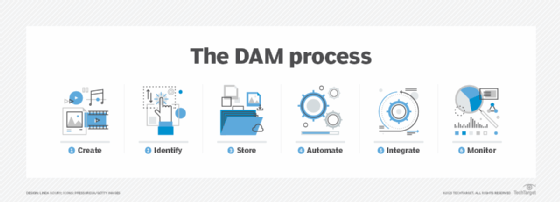
Getty Images/iStockphoto
MAM vs. DAM: What's the difference?
Digital asset management is the reigning champion of managing digital and multimedia assets. Now, media asset management offers the same, with more support for larger files.
As organizations store and manage more video than ever before, the time has come to determine whether a digital asset management system is enough to store all business content.
Media asset management (MAM) has risen out of organizations' increased need to store multimedia content -- particularly video files. The MAM system is incredibly similar to its predecessor, the DAM system, which also stores, manages and protects multimedia assets. While many people use the terms interchangeably, MAM and DAM have specific differences that organizations should note before adopting one or the other.
Learn how MAM vs. DAM compare, including their definitions, purposes and key differences.
What is DAM?
DAM is a subset of enterprise content management. It refers to an organization's processes to manage, store and organize multimedia assets, including images, videos and audio. DAM systems also manage digital rights and permissions -- including copyright and access control -- for these assets. Marketers commonly use DAM systems to create, access and store marketing materials, but sales teams, HR professionals and legal teams often use DAM software to store content securely.
Metadata -- data that describes other data -- plays a critical role in DAM because the system uses this detailed information to properly store and organize assets. Metadata often includes information about versioning, ownership, expiration dates and the type of media the asset is.

What is MAM?
MAM is an evolution of DAM. MAM systems can help organizations handle larger audio and video files with which DAM systems may struggle. For example, a PR firm or video production agency likely needs to store more and larger video and audio files than a hospital, so those organizations would benefit from a MAM system.
MAM systems also rely on metadata, but they often include more details about each asset to make it easier for users to search the system. For example, MAM metadata can include timestamps, so broadcast news or sports organizations can more easily find a video from a specific moment.
3 differences between MAM and DAM
While MAM and DAM are similar processes, the two differ regarding target audience, deployment and accessibility.
1. Target audience
DAM systems can handle various types of digital assets, while MAM systems can handle larger multimedia files that DAM platforms may struggle to store and make accessible. To decide whether to invest in MAM vs. DAM, organizations should consider employees' workflows and whether they need more video storage.
Organizations and teams that would benefit from DAM systems include the following:
- Marketing and sales teams.
- Real estate firms.
- Local governments.
- Educational firms.
- Retail organizations.
- Construction firms.
- Nonprofit organizations.
Organizations and teams that would benefit more from MAM systems include the following:
- Sports and news broadcast organizations.
- Video and film production agencies.
- Video production teams who require cloud-based editing access.
However, the use cases for MAM may continue to grow. Many organizations operate with remote or hybrid flexibility, meaning many meetings take place on video conferencing platforms. Organizations that frequently record meetings or trainings online may benefit more from a MAM than a DAM system to support the extra, larger video content.
2. Deployment
As DAM is more of a legacy technology, most vendors offer on-premises, cloud and hybrid deployment options. MAM systems are primarily cloud-based.
Currently, DAM systems have broader use cases than MAM software. Organizations in any vertical can benefit from a DAM system to handle images, emails, logos and other digital assets. However, the cloud access of MAM systems can help organizations with a lot of remote or hybrid employees who may interact most frequently online and require more flexible access.
3. Accessibility
As MAM vendors predominantly deploy their services in cloud environments, users can more easily access MAM systems from anywhere. Additionally, these systems are easier to search within due to their increased use of metadata for each asset. So, users can access the system from anywhere and find the content they need more easily.
On the other hand, DAM systems can exist on premises, in the cloud or in hybrid environments. If an organization uses a legacy, on-premises DAM system, its employees may struggle to easily access the system if they work remotely. Additionally, DAM systems can house assets that require increased security -- like cryptocurrency or blockchain -- as they can help organizations manage digital rights and permissions.
Overall, DAM isn't going away. These systems still suit most organizations, even if they continue to create, use and store more video files. However, the introduction of MAM may represent the future of business operations and an increased reliance on video technology and cloud-based accessibility.








